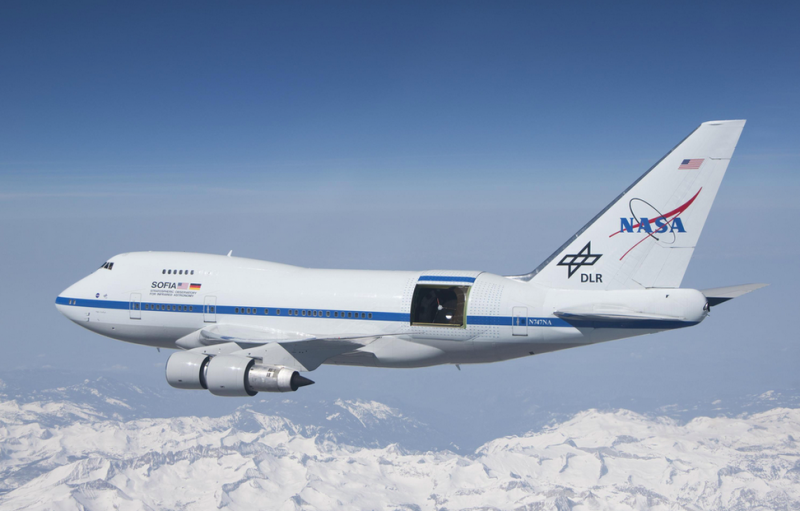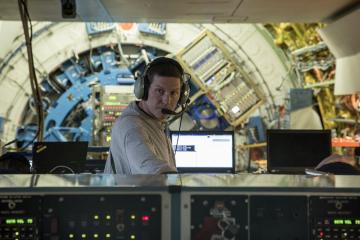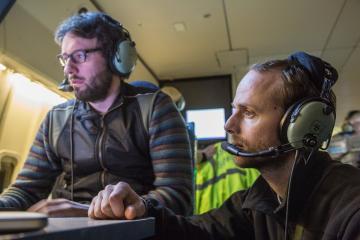SOFIA: a telescope operating from the stratosphere
The Orion nebula is an observational target since the earliest antiquity – first with the naked eye and then by means of ever more powerful telescopes, located for some on Earth (VLT, ALMA, IRAM), embarked for other on board satellites (Hubble, Herschel), and in different wavelength ranges: visible, infrared, radio.
The Orion nebula consists of a vast cloud of gas and dust within which are born, at a steady rate, stars of all types. Distant from Earth by “barely” 1500 light years, Orion is one of the regions of stellar formation closest to Earth. It is therefore a privileged observational target and a particularly interesting object of study for researchers interested in the formation of stars.

Olivier Berné is currently a CNRS researcher at the IRAP and is one of those researchers who devote part of their activities to observing and studying the Orion nebula. His research is part of the continuation of his two post-doctorates, one in Madrid in Spain and the other in Leiden in the Netherlands. Using IRAM’s 30-meter radio telescope, he first discovered the existence of structures called “waves of Orion” (1) and mapped this nebula in the millimetric domain. A second mapping, in the infrared domain this time, and centered on the Orion nebula, was deduced from data gathered by the Herschel space telescope.
On February 7, 2017, Olivier Berné boarded a Boeing 747 with a telescope of 2.5 meters of diameter operating in the far infrared: the telescope SOFIA (2) of the consortium NASA / DLR. Objective: drawing the very first map of the Orion constellation in the far infrared by observing the emission line of the Carbon ion, one of the most abundant particles of the interstellar medium.


The results of this study carried out in the framework of an international collaboration (3) and which will have required several flights over the period November-February 2017, will be published very soon.
Notes
(1) When the stellar wind from young and massive stars strikes the surface of the Orion molecular cloud, Kelvin-Helmotz-type instabilities occur, resulting in the appearance of “waves”-like structures within the gas
(2) Stratospheric Observatory for Infrared Astronomy
(3) This international collaboration gathers researchers from the CNRS, the University of Cologne in Germany, the University of Leiden in the Netherlands, the CSIC in Spain and the University of Maryland in the United States.
Further Resources
- Scientific Article :
- Olivier Berné, Núria Marcelino et José Cernicharo, « Waves on the surface of the Orion molecular cloud », Nature, volume 466, 19 août 2010, pages 947–949, DOI 10.1038/nature09289
- Images of the flight available within the CNRS photographic library
- Video of the flight acquired by CNRS Images and diffused by LeMonde.fr : “Embarquement immédiat pour les étoiles“
- Observations of the Orion constellation
- by the Hubble Space Telescope (NASA / ESA) : http://hubblesite.org/images/news/release/2006-01
- by the Herschel Space Telescope (ESA) : https://apod.nasa.gov/apod/ap161014.html
- by the MUSE instrument installed on the VLT (ESO) : http://www.irap.omp.eu/actualites/actu-musevlt
- by the ALMA interferometer (ESO) and the IRAM-30m radiotelescope : http://www.irap.omp.eu/actualites/actu-orion
- The SOFIA Telescope (NASA / DLR) : https://www.sofia.usra.edu/
- Results of the SOFIA mission : https://www.nasa.gov/mission_pages/SOFIA/index.html
- NASA Tumblr dedicated to SOFIA : Astronomy From 45,000 Feet. What is the Stratospheric Observatory for Infrared Astronomy, or SOFIA, up to?
IRAP Contact
- Olivier Berné, olivier.berne@irap.omp.eu






